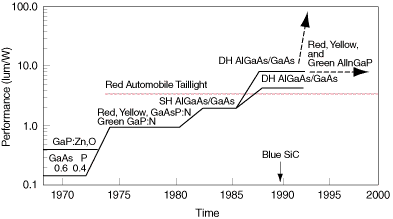|

Infrared Original Type
Gallium Arsenide (GaAs)
A spectral peak at 940 nm makes this LED invisible to the human eye. Voltage drop is 1.2 - 1.3 volts. Drive current is 50mA.
High-Efficiency Infrared
Gallium Aluminum Arsenide (GaAlAs) 880 nm & 940 nm
Gallium Aluminum Arsenide accounts for the higher efficacy as compared to the Gallium Arsenide LED. Also, this LED features a shorter peak wavelength—880 nm. Voltage drop is around 1.4 volts. Drive current is 50 mA. Because the spectral output extends into the low 800s nm (wavelengths visible to the human eye) this LED is dimly seen in a dark room.
Original High-Efficiency Red (630 nm)
1960 - Gallium Phosphide doped with Zinc & Oxygen (GaP: Zn, O)
This LED is efficient (1 to maybe 2 lumens/watt) at a few milliamps or less. At 20 mA, it's about 2 - 3 times as efficient as the original formula visible red LED.
Color varies with current. At 0.5 - 1.0 mA the LED output is nearly pure red, at higher currents it appears more orange. If the lamp is not tinted red, the emitted light color ranges from orange to yellowish-orange at 30 mA.
Spectral output is a broad band, nominally peaking at 697 nm and maybe only peaking that far out in the red at really low currents. At higher currents, there is a very weak secondary spectral band in the blue-green band around 510 nm.
Maximum drive current is usually 30 mA, but this LED has a noticeably nonlinear light output that increases less than proportionately with current above a few milliamps. Voltage drop is around 1.9 volts.
Original-Formula Visible Red
1968 - Gallium Arsenide Phosphide (GaAsP) on a Gallium Arsenide (GaAs) Substrate
Spectral output peaks around 660 nm. Color is a pure red. Efficacy is low. Most LEDs using this technology need a maximum continuous drive current of 50 mA, but at a typical current of 20 mA it is reasonably bright. Efficacy is maximized at currents of 20 mA and up. Voltage drop is 1.6 - 1.75 volts.
Ultra Brightness Red (660 nm)
1980 - Gallium Aluminum Arsenide Phosphide (GaAlAsP)
Overall luminous efficacy of this LED is, at best, 9 lumens/watt. Output peaks between 650 nm and 670 nm. Color is pure red to laser red with a dominant wavelength (monochromatic light of matching color) in the 640s but can range from about 635 to about 650 nm. Efficacy maximizes at currents near 20 - 25 mA. Voltage drop at 20 mA is 1.8 to 1.9 volts. Maximum rated drive current is 30 mA but sometimes 50 mA. Dimly glows at 1.5 volts.
High-Efficiency Red, and Orange
1990 - Gallium Arsenide Phosphide (GaAsP) on Gallium Phosphide (GaP) substrate
This was the first non-low-current, high-efficiency red LED. The Gallium Phosphide substrate is transparent to the emitted light and Gallium Arsenide is not. This is one reason why this LED is more efficient than the original-formula red. Color is orange-red with a dominant wavelength around 620 nm. A slight variation of this has a dominant wavelength usually around 610 - 615 nm and is considered orange. Drive current is 5 - 20 mA. Maximum current is 30 mA. Voltage drop at 20 mA is around 1.9 volts.

|